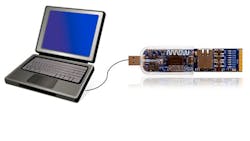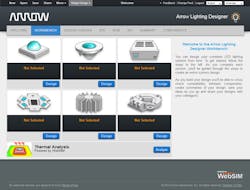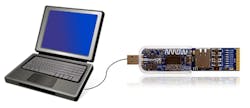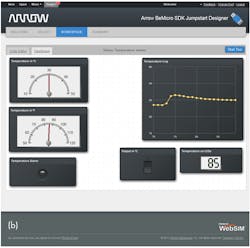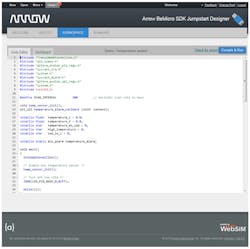The Internet has brought about swift and meteoric changes in the electronics industry, fast-tracking many trends. In particular, product marketing and support increasingly use the Internet for applications that go well beyond the traditional provision of information in the form of videos, data sheets, and application notes.
Related Articles
- Tap Online Design Tools To Improve Your Power Subsystem Designs
- The Rise Of The Online Circuit-Design Collective
- Evaluation Boards Key To Updating Engineering And Technology Education
In the meantime, the mobile Internet with 3G and now 4G LTE already provides sufficient bandwidth for complex technical applications to be performed problem-free and fast enough from any location. The development of new browser technologies has in turn contributed to the development of compatible Web applications without additional software packages such as Java or Flash.
In the summer of 2010, Arrow made a strategic acquisition in the form of Transim, a provider of online design solutions. Since then Arrow’s engineering teams have worked with Transim to develop a range of online engineering solutions, migrating some key evaluation boards and software development kits (SDKs) into the cloud.
Online Engineering Solutions
One of Arrow’s first online engineering solutions was the Arrow Lighting Designer (http://transim.arrow.com/lighting), a tool that offers design support for product development of lighting devices (Fig. 1).
The application not only supports the designer in the selection of LEDs or suitable driver components, it also offers optical components, an online floor planner for the board layout, a heatsink designer, and suitable plug connectors. When it comes to configuring the application, users have a range of test and analysis options at their disposal. Transim’s proprietary Web simulation platform allows the engineer to get a quick overview of the electrical behaviour or even the heat distribution, e.g., in an LED lamp, with the aid of a 3D finite element analysis.
The latest release of the application offers a reference library, selection support for lighting modules, and a design wizard, making it even easier to work with the tool. As with other online applications from Arrow, users also can store their designs in a cloud-based storage system and access them again later at any time. The design-sharing feature permits designs to be easily sent to other users at the touch of a button. These other users then can open these designs in their browsers, view them, and even edit them.
Hardware Integration Included
Arrow recently released a new generation of online engineering solutions that address a typical problem many semiconductor manufacturers have with what are, in the broadest sense, configurable products such as MCUs, FPGAs, or digital power management. Many evaluation kits are available for all these products. These kits provide users with a good starting point for their development tasks, but also involve a considerable learning curve.
Particularly in embedded computing, users have the option of purchasing an evaluation kit. After obtaining the hardware, they can download and install the corresponding development environment. These environments are often very large and powerful. They are also very complex and cannot be used without extensive training, though, placing significant demands on the user, especially with regard to the preliminary evaluation of a defined product.
The BeMicro Jump Start Designer (http://arrow.transim.com/bemicro) takes a somewhat different approach here. To provide an easy introduction for those who may be interested in Altera FPGAs and to explain the various possibilities of FPGA programming, Transim has developed an online development environment based on the Arrow BeMicro stick SDK (Fig. 2).
After receiving the USB SDK, users can decide whether they want to just download the Altera development environment or “test drive”the stick in the online environment first without having to install the development environment straight away.
The Jump Start Designer gives users a whole range of demo applications that can be easily modified and re-compiled in the online editor. If the new firmware has been created on the server, it is automatically sent back to the browser, where it is then transferred from the browser to the BeMicro stick connected via USB using a special communication module.
Bidirectional communication between the browser and the SDK means that so-called dashboards can be defined (Fig. 3). Users can influence hardware functions and view data available in the SDK (such as the temperature at the integrated temperature sensor), all in real time, as well.
Hardware Evaluation In The Cloud
Arrow Cloud Connect goes a step further. Based on the Freescale Freedom board that a Cortex M0+-based MCU has, users can program the microcontroller directly from the browser and link their application to a cloud service from iDigi.
To do this, Cloud Connect uses the computer’s Internet connection to store data gathered on the evaluation board in a cloud-based storage system. The integrated dashboards can then display data directly from the evaluation board or access the data from the cloud storage. In the case of the latter, users do not necessarily even have to be connected to the actual hardware, but can still access the latest information from their board at any time.
Like the BeMicro, the application has an integrated online integrated development environment (IDE) with syntax highlighting plus file and project management. Firmware is created on the server in real time and can be transferred to the microcontroller via the USB drive integrated in the board. A USB-to-UART interface is used for direct communication with the board.
The integrated community function allows the exchange of designs. In addition to a code library, users have, among other things, an extensive help system and forum at their disposal. For example, the forum already includes a dashboard that displays the temperature in the living room of one user.
Right From The Beginning
In some areas of the semiconductor industry, online engineering has already become a permanent fixture in the portfolio of marketing and application engineering divisions. Started by National Semiconductor together with Transim in 2000, the technology has proved itself a thousand times over in the design of complex analog or power management applications.
Since then the obvious advantages, such as engineering bandwidth, worldwide availability, easy and efficient access, and faster product application, have also sparked interest among manufacturers of configurable products. Furthermore, online design lends itself to other areas of semiconductor technology.
For example, manufacturers of high-speed plug connectors can give their customers a better understanding of their products with the aid of online signal integrity analysis, which is now available from Transim. Likewise, the new 3D thermal engine allows practically any number of geometric structures to be analyzed online, and the multi-domain Portunus solver supports the design of drive systems. Other applications in RF and microwave or antenna design are also supported.
Online engineering tools are yet another example of how the Internet can simplify our workflow. Transim has made the first steps in this direction with its new Web-based design solutions, and other projects are already in development.
About the Author
Uwe Knorr
Marketing and Sales
Uwe Knorr studied cybernetics and automation technology at the Chemnitz University of Technology, Germany, obtaining a master’s degree in electrical engineering in 1988. From 1988 through 1991 he continued his studies at the same university, finishing with his PhD thesis in the field of simulation of power electronic systems. After school he and two other students from the university started SIMEC GmbH & Co. KG, the maker of Simplorer, a simulation package for power electronics, drive systems, and alternative energy applications. After successful market introduction in Europe and North America, SIMEC was acquired by Ansoft Corp., where he worked as vice president of the EM Division and later as vice president of the sales Atlantic region. Since 2005, he has run marketing and sales at Transim Technology Corp.
